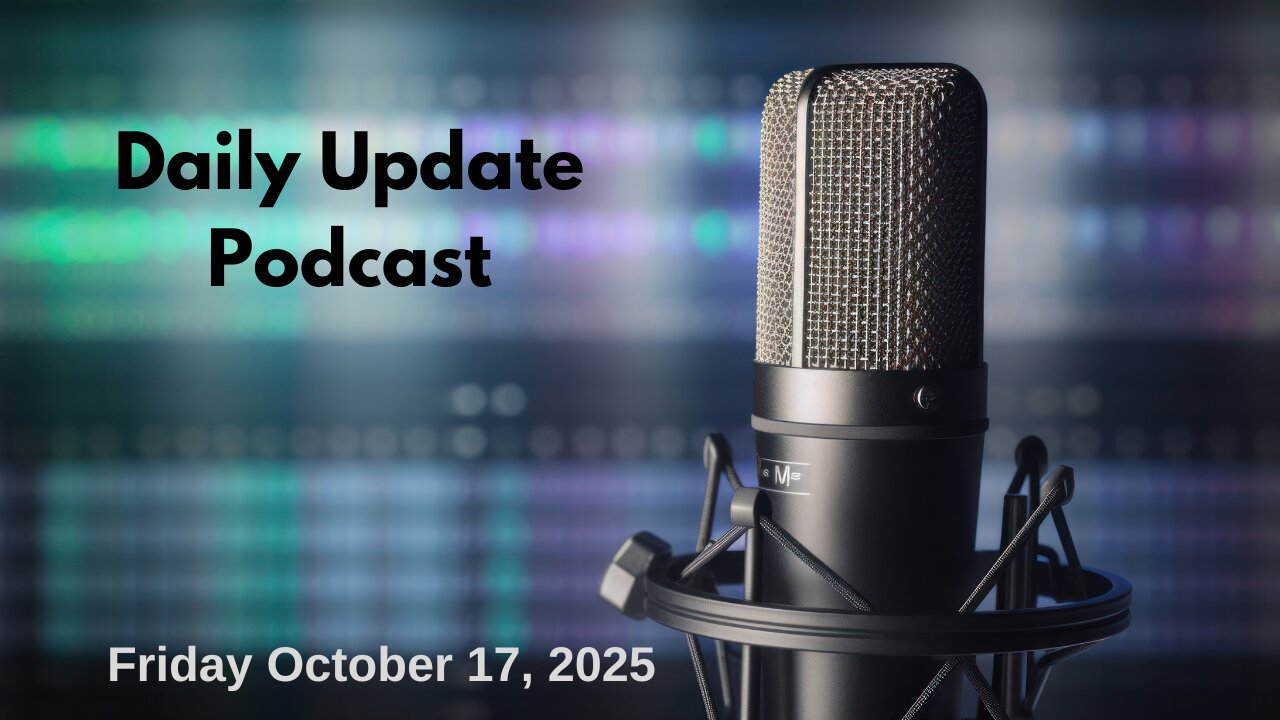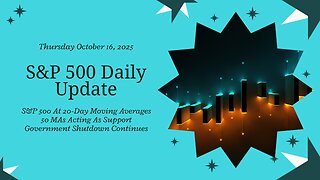Premium Only Content

Daily Update Podcast for Friday October 17, 2025
Link to The SPX Investing Program https://spxinvesting.substack.com
Link to The Daily Pivot Newsletter: https://thedailypivotnewsletter.substack.com/
Link to Video-Only Immediate Access:
https://spxvideos.substack.com/
Market Summary for Thursday, October 16, 2025:
Outlook for Friday, October 17, 2025:
Market Performance on October 16:
The S&P 500 opened higher but hit resistance at 6700, then declined below the daily pivot (6669) and S1 support (6614), finding support at 6,600 before closing above S1, down 0.63% on above-average volume.
Short-term trend remains negative, intermediate-term is above the 50-period moving average, and long-term is positive.
Small and mid-cap stocks underperformed, with the S&P 600 small-cap index down 1.26% and the Russell 2000 down over 2%.
The financial sector, particularly regional banks, showed significant weakness, underperforming the S&P 500, raising concerns about potential broader issues.
The VIX rose to 25.31, indicating increased market fear, with the RSI suggesting the VIX may have risen too quickly.
Economic and Geopolitical Context:
Interest rates fell below 4% on the 10-year yield, reflecting a flight to safety from stocks to bonds, viewed negatively in this context.
The Philadelphia Fed Manufacturing Index came in at -12.8 (vs. expected +9.1), while the NAHB Housing Market Index was 37 (vs. expected 33). The Treasury budget showed a $198 billion surplus, with the 2025 deficit lower than 2024’s at $1.775 trillion.
Geopolitical developments included a reported productive call between Presidents Trump and Putin, with plans to meet in Hungary to discuss the Ukraine war, and ongoing U.S.-China trade tensions.
Market sentiment turned extremely negative (below 25), potentially a contrarian bullish signal, though prolonged pessimism is possible.
Technical Indicators:
Momentum and trend indicators are negative in the short term, with the red line above the green line in several charts. Intermediate and long-term trends remain positive, supported by the 50-period and 200-period moving averages.
The market is overvalued, with a U.S. PE ratio of 21.4 and a median PE of 26.2 (vs. a 61.5-year median of 17.9).
Smart money indicators (e.g., accumulation distribution, Chaiken Money Flow & Oscillator) turned negative in the short term, while longer-term indicators like the vortex and bullish percent indices remain positive.
A potential Hindenburg Omen awaits confirmation by November 7, while a Zweig NYC breadth thrust could confirm by October 24, potentially bullish.
Sector and Stock Performance:
Financials, especially regional banks, were the weakest sector, down 2.78%, with concerns about smaller banks impacting the Russell 2000 (10% regional bank weighting).
Tech held up better, with NVIDIA up over 1%, though Microsoft, Apple, Amazon, and Tesla were down. Semiconductors outperformed the broader tech sector.
Healthcare is showing defensive positioning, underperforming but attracting some capital.
Outlook for October 17:
The S&P 500 remains range-bound between the 20-period (resistance) and 50-period (support) moving averages, negative in the short term but positive in intermediate and long terms.
Economic data expected includes housing starts, building permits, import/export prices, industrial production, and capacity utilization, though the government shutdown may delay some releases.
Options expiration on Friday historically has a 73% chance of an up week since 1980, but October 17 shows mixed performance (neutral to negative for the Dow, neutral to positive for the Nasdaq and S&P).
Seasonal trends suggest potential weakness in late October but a positive finish to 2025.
Ongoing geopolitical issues (Israel-Hamas, Venezuela, U.S.-China trade) and the government shutdown add uncertainty.
Conclusion:
The S&P 500 is showing short-term weakness, particularly in financials and regional banks, with increased fear (VIX above 25) and a flight to safety into bonds. While intermediate and long-term trends remain positive, negative momentum and sentiment indicators suggest caution. Investors should monitor regional bank developments, upcoming economic data, and potential confirmation of technical signals like the Hindenburg Omen or Zweig breadth thrust.
-
 41:36
41:36
The SPX Investing Program
4 days agoS&P 500 Daily Update for Thursday October 16, 2025
32 -
 1:54:09
1:54:09
Redacted News
3 hours agoBREAKING! Another Trump assassination plot foiled? New info in Charlie Kirk's murder | Redacted
155K135 -
 1:03:40
1:03:40
TheCrucible
2 hours agoThe Extravaganza! EP: 56 with Geust co-host Rob Noerr (10/20/25)
12.7K2 -
 LIVE
LIVE
The Jimmy Dore Show
1 hour agoIsrael STILL KILLING Gazans Despite Ceasefire! No Kings March Was A Complete Fraud! w/Katie Pasitney
4,892 watching -
 DVR
DVR
Kim Iversen
3 hours agoTrump EMBARRASSED: Gets Played by Israel AND China
20.3K76 -
 LIVE
LIVE
Side Scrollers Podcast
1 day ago🔴SIDE SCROLLERS FUND-A-THON🔴DAY 1🔴100% REVENUE HELPS CHANGE CULTURE!
901 watching -
 LIVE
LIVE
Tundra Tactical
4 hours ago $4.09 earnedThe Great Tundra Nation Gaming Stream!!! Featuring ThePiggNation
81 watching -
 LIVE
LIVE
Jamie Kennedy
17 hours agoAre We Being Harvested by Our Own Outrage? | Ep 227 HTBITY with Jamie Kennedy
126 watching -
 LIVE
LIVE
Wayne Allyn Root | WAR Zone
4 hours agoWatch LIVE: The War Zone Podcast with Wayne Allyn Root
42 watching -
 LIVE
LIVE
LFA TV
21 hours agoLIVE & BREAKING NEWS! | MONDAY 10/20/25
926 watching